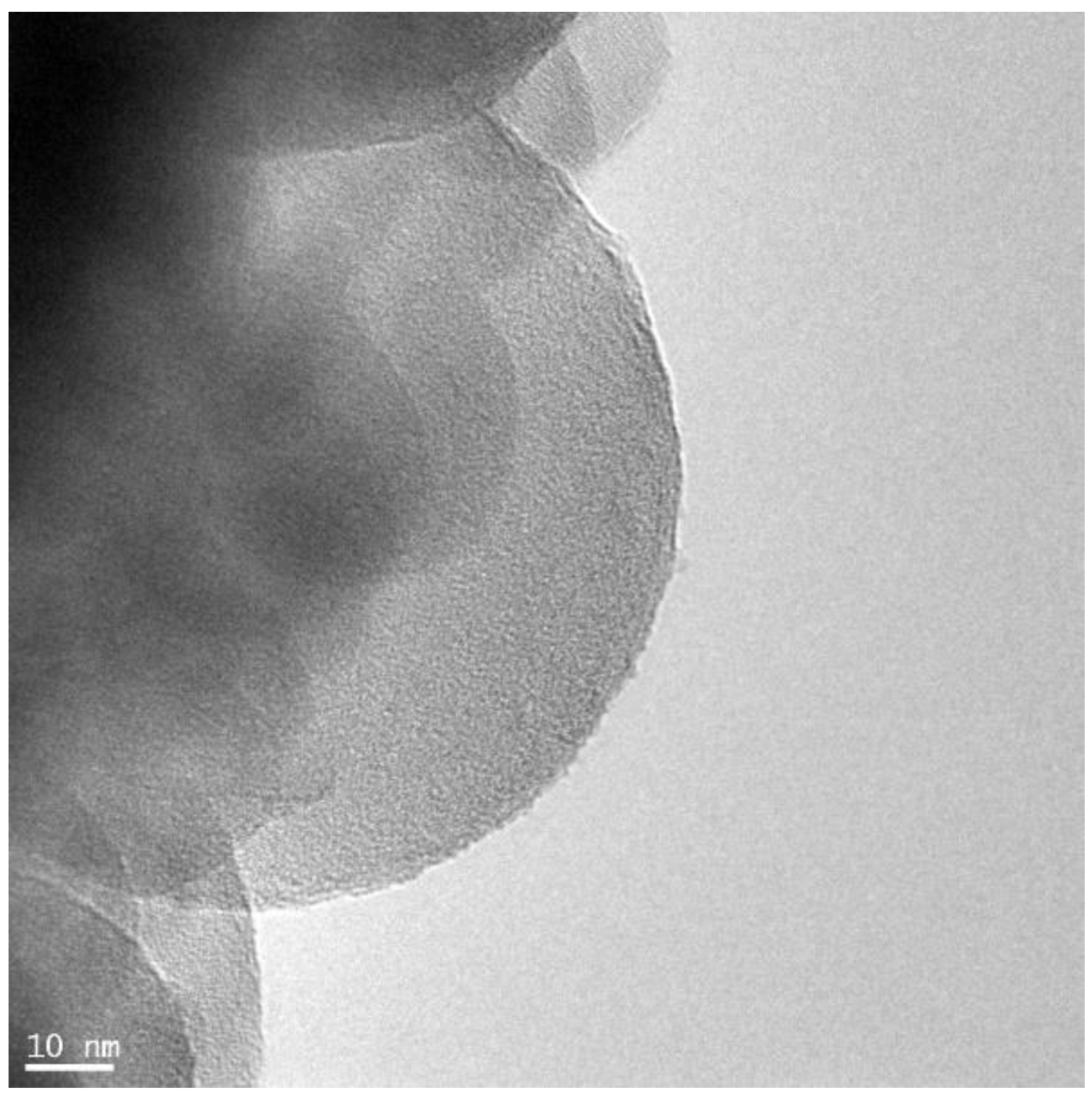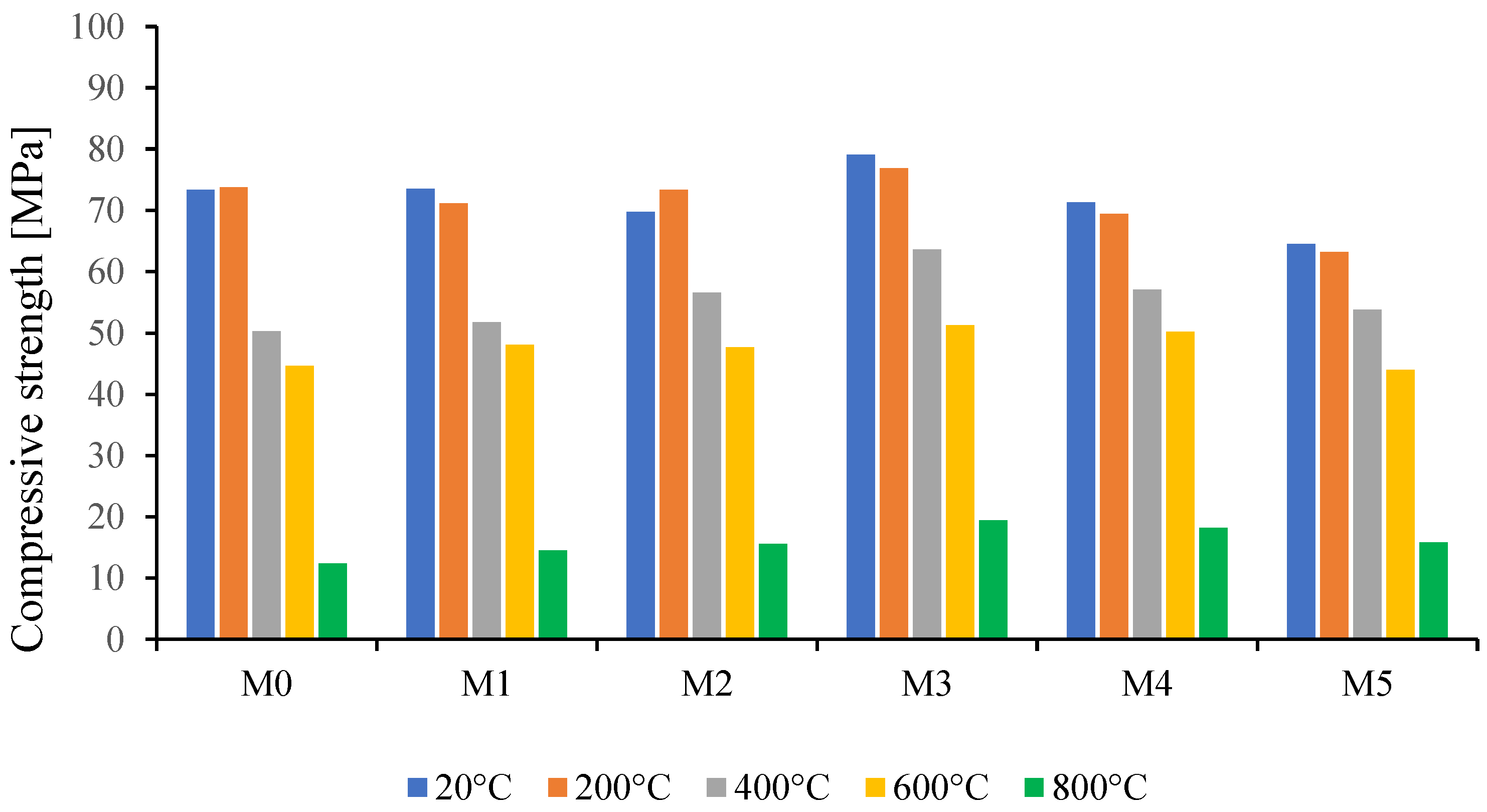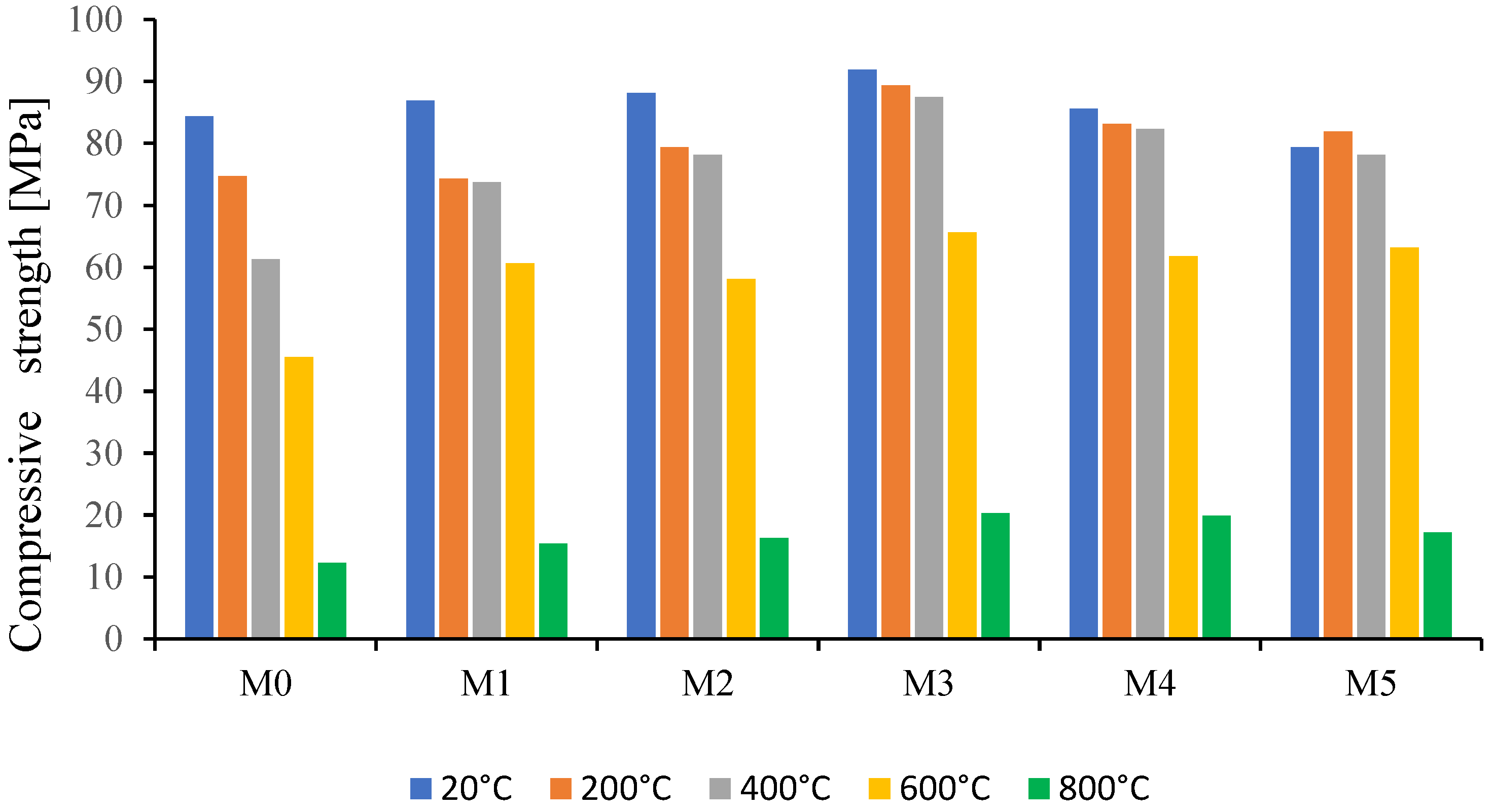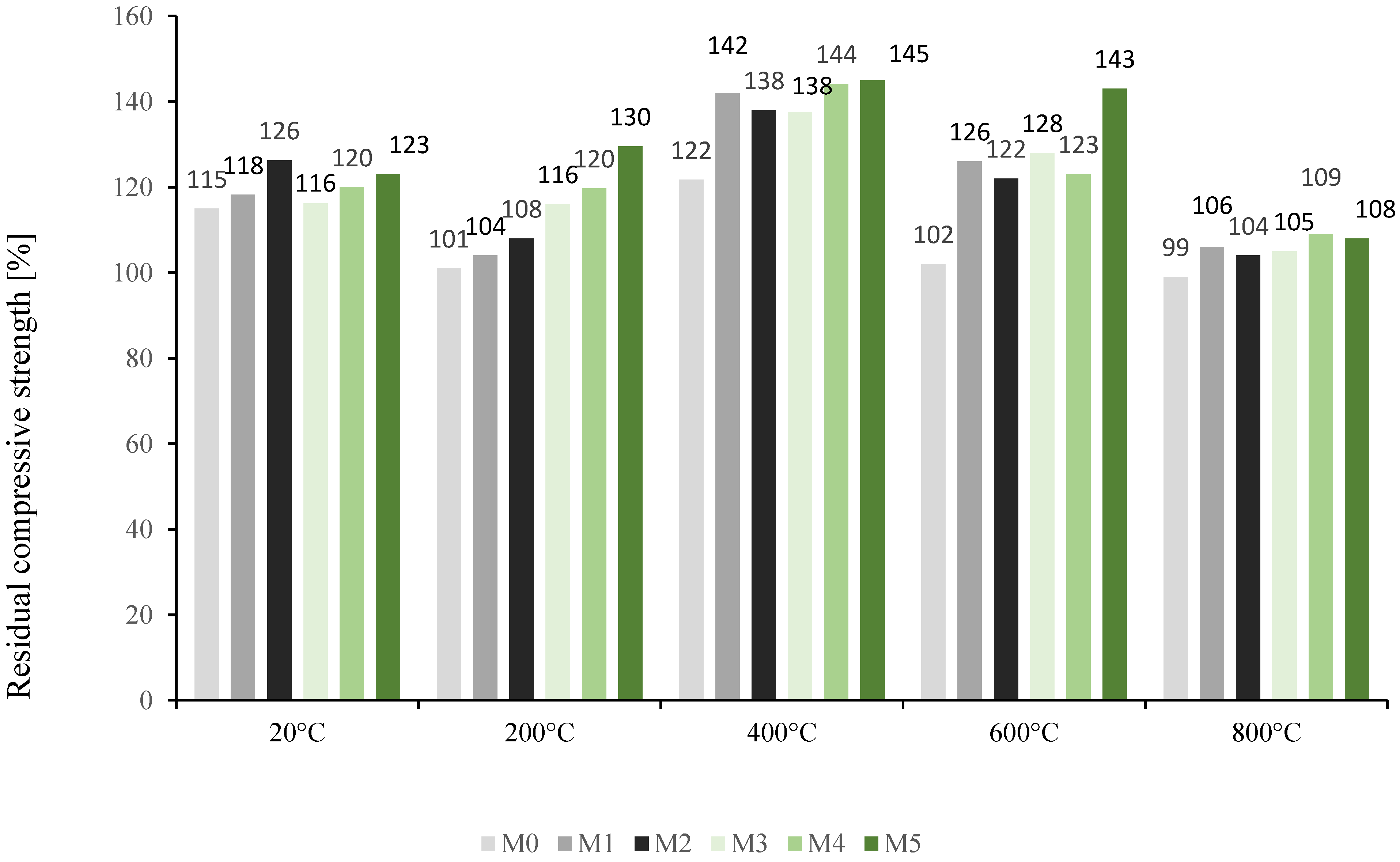The Influence of the Ageing Process on the Mechanical Properties of Cement Mortars with Nano-SiO2 Admixture Initially Subjected to Thermal Treatment †
Abstract
:1. Introduction
2. Materials and Methods
2.1. Materials
2.2. Samples and Their Storage
2.3. Test Methods
3. Results and Discussion
3.1. Compressive Strength after Heating
3.2. Mechanical Property Recovery by Mortars Damaged at High Temperature
4. Conclusions
Author Contributions
Funding
Institutional Review Board Statement
Informed Consent Statement
Data Availability Statement
Conflicts of Interest
References
- Korsun, V.I.; Vatin, N.; Korsun, A.; Nemova, D. Physical-Mechanical Properties of the Modified Fine-Grained Concrete Subjected to Thermal Effects up to 200 °C. Appl. Mech. Mater. 2014, 633–634, 1013–1017. [Google Scholar] [CrossRef]
- Korsun, V.; Baranov, A. Mechanical Properties of High-Strength Concrete after Heating at Temperatures up to 400 °C. In Proceedings of the International Scientific Conference on Energy, Environmental and Construction Engineering, St. Petersburg, Russia, 19–20 November 2020; Springer International Publishing: Berlin/Heidelberg, Germany; pp. 454–463. [Google Scholar]
- Handoo, S.K.; Agarwal, S.; Agarwal, S.K. Physicochemical, Mineralogical, and Morphological Characteristics of Concrete Exposed to Elevated Temperatures. Cem. Concr. Res. 2002, 32, 1009–1018. [Google Scholar] [CrossRef]
- Xu, Y.; Wong, Y.L.; Poon, C.S.; Anson, M. Impact of High Temperature on PFA. Cem. Concr. Res. 2001, 31, 1065–1073. [Google Scholar] [CrossRef]
- Husem, M. The Effects of High Temperature on Compressive and Flexural Strengths of Ordinary and High-Performance Concrete. Fire Saf. J. 2006, 41, 155–163. [Google Scholar] [CrossRef]
- Alonso, C.; Fernandez, L. Dehydration and Rehydration Processes of Cement Paste Exposed to High Temperature Environments. J. Mater. Sci. 2004, 39, 3015–3024. [Google Scholar] [CrossRef]
- Wang, H.Y. The Effects of Elevated Temperature on Cement Paste Containing GGBFS. Cem. Concr. Compos. 2008, 30, 992–999. [Google Scholar] [CrossRef]
- Peng, G.-F.; Huang, Z.-S. Change in Microstructure of Hardened Cement Paste Subjected to Elevated Temperatures. Constr. Build. Mater. 2008, 22, 593–599. [Google Scholar] [CrossRef]
- Henry, M.; Darma, I.S.; Sugiyama, T. Analysis of the Effect of Heating and Re-curing on the Microstructure of High-Strength Concrete Using X-ray CT. Constr. Build. Mater. 2014, 67, 37–46. [Google Scholar] [CrossRef]
- Li, Q.; Yuan, G.; Shu, Q. Effects of Heating/Cooling on Recovery of Strength and Carbonation Resistance of Fire-Damaged Concrete. Mag. Concr. Res. 2014, 66, 925–936. [Google Scholar] [CrossRef]
- Noman, M.; Yaqub, M. Restoration of Dynamic Characteristics of RC T-Beams Exposed to Fire Using Post Fire Curing Technique. Eng. Struct. 2021, 249, 113339. [Google Scholar] [CrossRef]
- Usman, M.; Yaqub, M.; Auzair, M.; Khaliq, W.; Noman, M.; Afaq, A. Restorability of Strength and Stiffness of Fire Damaged Concrete Using Various Composite Confinement Techniques. Constr. Build. Mater. 2021, 272, 121984. [Google Scholar] [CrossRef]
- Xuan, D.X.; Shui, Z.H. Rehydration Activity of Hydrated Cement Paste Exposed to High Temperature. Fire Mater. 2011, 35, 481–490. [Google Scholar] [CrossRef]
- Brzozowski, P.; Strzałkowski, J.; Rychtowski, P.; Wróbel, R.; Tryba, B.; Horszczaruk, E. Effect of Nano-SiO2 on the Microstructure and Mechanical Properties of Concrete under High Temperature Conditions. Materials 2022, 15, 166. [Google Scholar] [CrossRef] [PubMed]
- PN-EN 196-1:2016-07; Methods of testing cement—Part 1: Determination of strength. Polish Committee of Standardization: Warsaw, Poland, 2016.
- Poon, C.-S.; Azhar, S.; Anson, M.; Wong, Y.-L. Strength and durability recovery of fire-damaged concrete after post-fire-curing. Cem. Concr. Res. 2001, 31, 1307–1318. [Google Scholar] [CrossRef]
- Henry, M.; Suzuki, M.; Kato, Y. Behavior of fire-damaged mortar under variable re-curing conditions. ACI Mater. J. 2011, 108, 281–289. [Google Scholar] [CrossRef]
- Horszczaruk, E.; Sikora, P.; Cendrowski, K.; Mijowska, E. The effect of elevated temperature on the properties of cement mortars containing nanosilica and heavyweight aggregates. Constr. Build. Mater. 2017, 137, 420–431. [Google Scholar] [CrossRef]




| Mortar Designation | Cement (kg/m3) | Water (kg/m3) | Magnetite (kg/m3) | NS (% of Cement Mass) | NS Dispersion (kg/m3) |
|---|---|---|---|---|---|
| M0 | 450 | 225 | 2439 | 0 | 0 |
| M1 | 450 | 220.5 | 2439 | 1 | 9 |
| M2 | 450 | 216 | 2439 | 2 | 18 |
| M3 | 450 | 221.5 | 2439 | 3 | 27 |
| M4 | 450 | 207 | 2439 | 4 | 36 |
| M5 | 450 | 202 | 2439 | 5 | 45 |
Disclaimer/Publisher’s Note: The statements, opinions and data contained in all publications are solely those of the individual author(s) and contributor(s) and not of MDPI and/or the editor(s). MDPI and/or the editor(s) disclaim responsibility for any injury to people or property resulting from any ideas, methods, instructions or products referred to in the content. |
© 2023 by the authors. Licensee MDPI, Basel, Switzerland. This article is an open access article distributed under the terms and conditions of the Creative Commons Attribution (CC BY) license (https://creativecommons.org/licenses/by/4.0/).
Share and Cite
Horszczaruk, E.; Łukowski, P. The Influence of the Ageing Process on the Mechanical Properties of Cement Mortars with Nano-SiO2 Admixture Initially Subjected to Thermal Treatment. Mater. Proc. 2023, 13, 20. https://doi.org/10.3390/materproc2023013020
Horszczaruk E, Łukowski P. The Influence of the Ageing Process on the Mechanical Properties of Cement Mortars with Nano-SiO2 Admixture Initially Subjected to Thermal Treatment. Materials Proceedings. 2023; 13(1):20. https://doi.org/10.3390/materproc2023013020
Chicago/Turabian StyleHorszczaruk, Elżbieta, and Paweł Łukowski. 2023. "The Influence of the Ageing Process on the Mechanical Properties of Cement Mortars with Nano-SiO2 Admixture Initially Subjected to Thermal Treatment" Materials Proceedings 13, no. 1: 20. https://doi.org/10.3390/materproc2023013020
APA StyleHorszczaruk, E., & Łukowski, P. (2023). The Influence of the Ageing Process on the Mechanical Properties of Cement Mortars with Nano-SiO2 Admixture Initially Subjected to Thermal Treatment. Materials Proceedings, 13(1), 20. https://doi.org/10.3390/materproc2023013020






